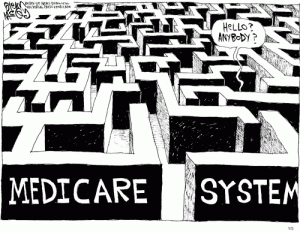By Jack Cumming
Steve Moran, who is well-known to Foresight readers, often inspires my thinking, and a recent article of his fits the pattern. In it, Steve reflects on data presented at the National Investment Center’s Data & Analytics Conference and on the leadership challenge in responding to the data. One of his conclusions: “Figuring out how to use data in a way that is consumable and actionable remains a big challenge.”
Steve’s Inspiration
He also lists common perceptions among the senior living insider leadership group.
It is clear senior living is on the verge of something …
- Better
- New
- Different
- Transformative
- Generational
The insiders have been saying that to each other for at least the past decade. In the meantime, not much of significance has changed. Today’s new communities look much like those of 20 years ago, and so on.
Steve then goes on to reflect that the torch of leadership is slowly being passed to a new generation of leaders, younger in age and more innovative in their ideas. Although he didn’t name names, Sheri Peifer, Jim Petty, Darolyn Jorgensen-Kares, Sean Kelly, and Chris Bird came to my mind.
Thinking Ahead
At that point, my mind took flight. Will the future of senior living involve coaxing people into housing, or will it transition to serving them where they are until there’s no alternative? I thought of a conversation I had recently with a senior salesperson for Sunrise Senior Living. I asked her what made their offering unique.
She responded that they were equipped to handle higher acuity oldsters — e.g., those needing a two-person transfer — but that they’re not a skilled nursing facility. She didn’t say, but I thought, “How wonderful. A homelike living environment for end-of-life support.”
I couldn’t help but think that, if that is so, then Sunrise is perfectly set to connect with people as “members” while they are still living where they have long chosen to live. Membership could allow them to maintain their accustomed lifestyle knowing that responsive services are available when, and if, the need arises. Why is that model now so rare?
Boomer Salvation?
The data that insider pundits revel in is the arrival of the baby boomers with their demographic explosion. The belief is that demographics will lift all providers to new heights of prosperity. So far, all the demographics have done is to offset a growing buyer reluctance to move in, allowing the industry to hold its own.
As the market based on demographics and eligibility has expanded, market share has dropped, but the growth in the market has offset market share losses to keep things on a relatively even keel. That is unlikely to last, and in the interim, the housing product offered is aging.
Just one example of dated concepts, mass dining still predominates. Another, residential units for couples seldom have two sinks in the master bath. That’s not to mention lagging technology. As alluded to earlier, few providers engage their potential residents as members in their offerings. There’s no reason not to convert the waiting list to a membership, with the residential building as a clubhouse. The list of missed opportunities goes on and on.
Fresh Leadership
Will a new generation of leaders, now in their 40s and 50s, transform senior living from what they have inherited to what they might wish for themselves? After all, it won’t be long before they transition from leaders to prospects themselves. That’s a big question. It’s hard to reform what an executive inherits. It’s easier to start fresh and create something new. No one likes to have to tell outdated subordinates that they no longer fit.
Still, there is a solid base of knowledge and experience with today’s care-oriented industry. Perhaps some dynamic leader will emerge who is able to lead the change that will keep senior living thriving well into the second half of the 21st century.
Customers or Profit?
Entrepreneurs know they need customers, so successful entrepreneurs put customer value before all other considerations, often to their detriment if they endanger solvency. Still, as with Jeff Bezos and Amazon, sound entrepreneurs bring great social benefits and consumer value. Their successors most often put profit harvesting first, resulting in enterprise decline as customers find better value elsewhere.
For instance, one wonders why there is no credible nationwide brand in senior living other than A Place for Mom, which incentivizes fees over quality in its placements. A national senior living brand — whether conglomerate or consortium — could improve on APFM, relegating it to history, and a trustworthy national brand might set standards that could lift the reputation of senior living above the reproaches that now appear too often in the media. Let’s make senior living shine.








